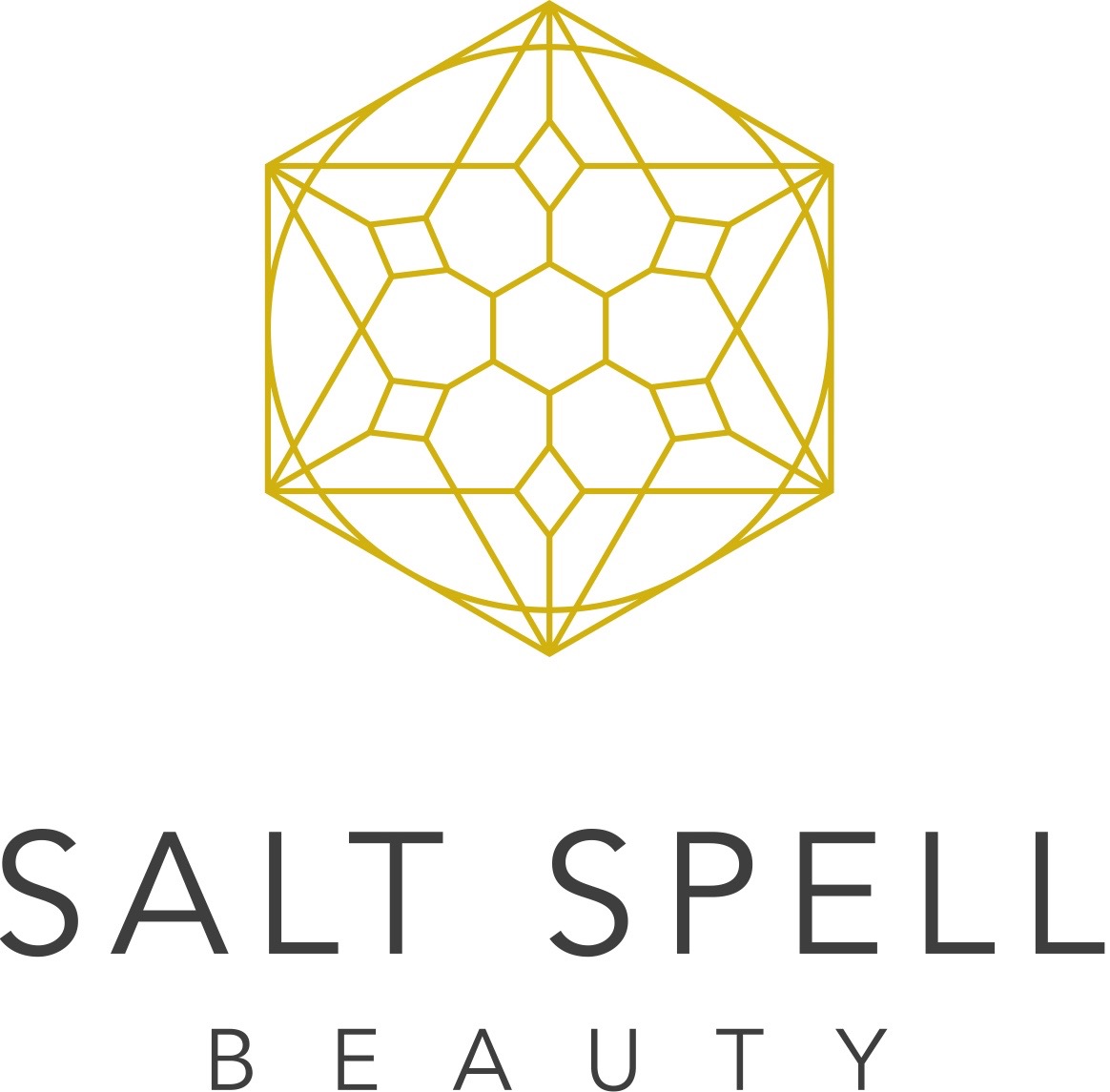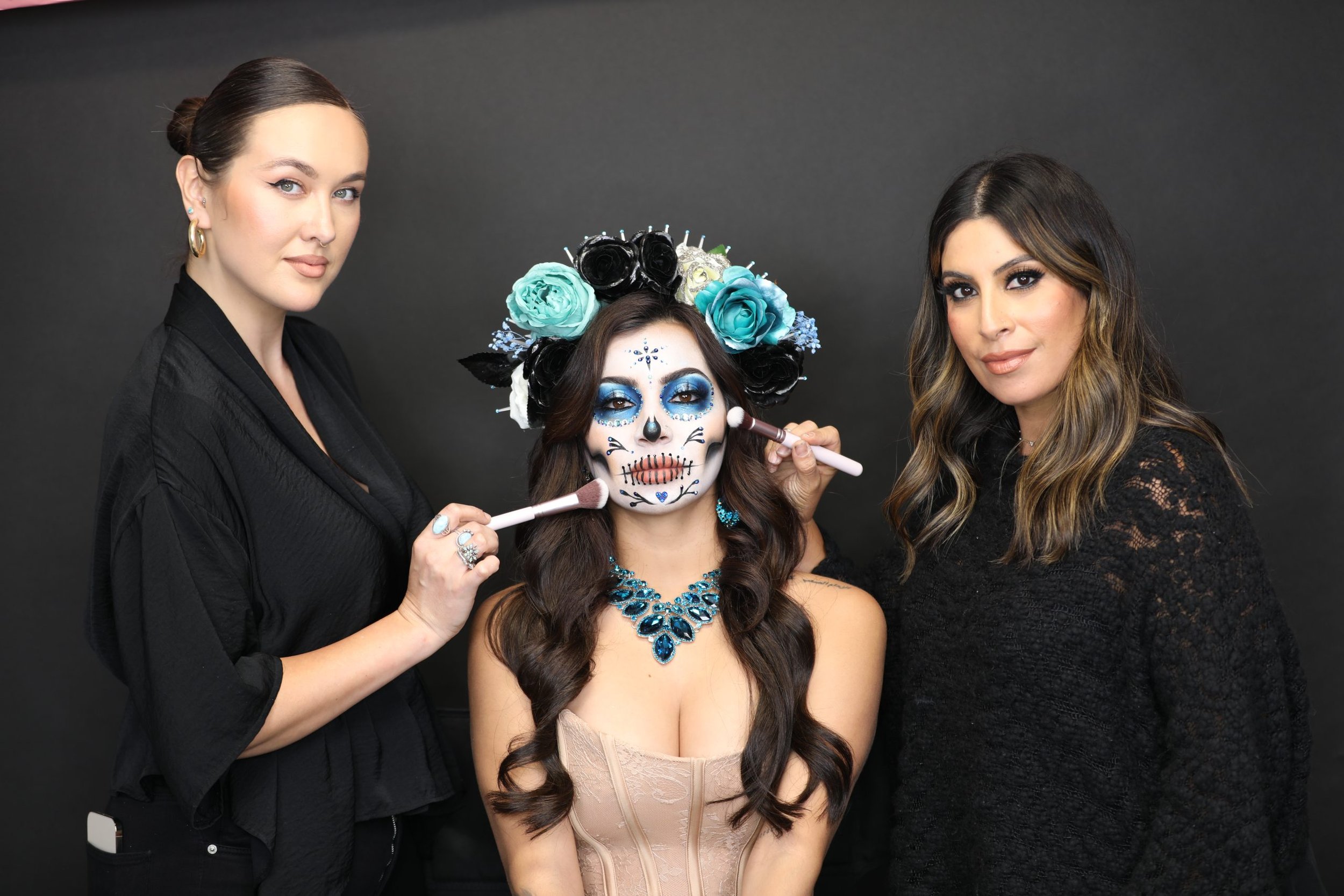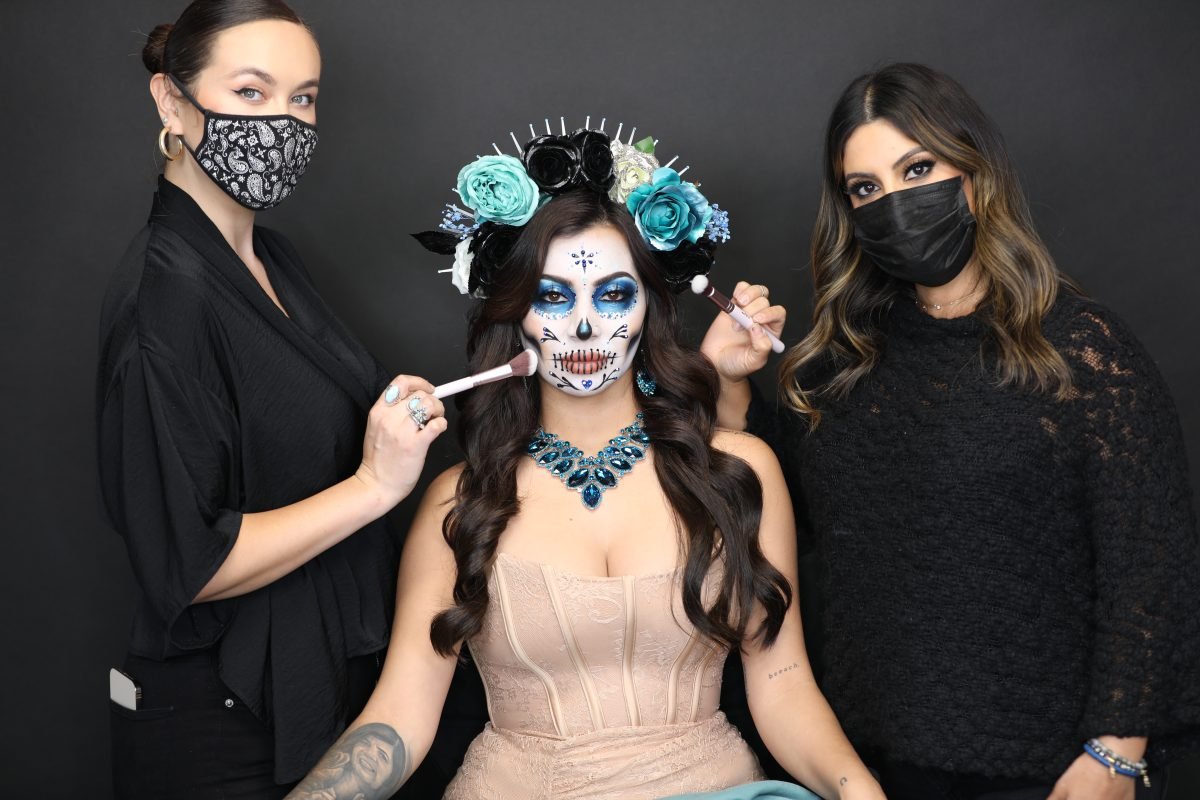It’s late October, and grey clouds cast a cool hush over Los Angeles, making the orange pumpkins and marigolds pop. Halloween is just around the corner, and Mari and Drea are gearing up for Día de los Muertos. Every year for the past 7 years, this duo creates intricate sugar skull makeup looks (aka Catrinas) to mark the Mexican holiday, transforming themselves into ethereal, otherworldly beings in remembrance of loved ones who have passed. Their sugar skull makeup artistry has been featured in POPSUGAR Latina, Refinery29 and HuffPost. This year they had the honor of a feature in Latina Magazine, in collaboration with El Jimador Tequila and Evette XO.
We sat down with Mari and Drea to dive into their unique and longstanding tradition of creating sugar skull makeup looks for Día de los Muertos—a yearly celebration that lies at the intersection of their identities as Mexican-American makeup artists. Read on to hear about this year’s sugar skull makeup inspiration, and their thoughts on cultural appreciation vs. appropriation, and what beauty products they would take beyond the grave. But first, a little cultural background on Day of the Dead:
Día de los Muertos is a Mexican festival with Aztec origins tracing back to the goddess Mictecacihuatl, aka “Lady of the Dead.” Today, the tradition has evolved with Catholic influence into a celebration on November 1 (All Saints’ Day, which celebrates children who have died) and November 2 (All Souls’ Day, which celebrates adults). It is believed that the veil between the seen and unseen world is at its thinnest this time of year—hence spooky Halloween celebrations in the days prior.
As macabre as it might sound to the uninitiated, Día de los Muertos is a celebration of life and legacy. This tradition honors the dead, calling those who have passed back into the present with altars (ofrendas) filled with photos of deceased loved ones and their favorite things like food, drink and heirlooms. Orange marigold blossoms adorn the altar, alongside the most recognized hallmark of Día de los Muertos: sugar skulls (calaveras) covered in brightly colored designs. (Psst: For more info on DDLM Altars, peep this Smithsonian article!)
Q: What does Día de los Muertos tell us about Mexican culture?
Drea: What Día de los Muertos reveals about Mexican culture is our devotion to family, ancestors, and those who contribute to making us who we are. It’s about keeping your family history and the memories of the people you love alive. It reveals the depth and reverence we have for family—and in Mexican culture there’s usually a lot of us! Our big Día de los Muertos celebration brings us together to remember the family we lost. We don’t forget about our family, we keep them alive in the way we honor them. Mexican culture has this way of being loud, playful, vibrant and fun—but also very soulful, reverent and deep at the same time. That’s how you get a holiday like Día de los Muertos.
Mari: Mexican culture says let’s take something that everyone is afraid of—death—and turn it into the most wild, bold celebration you can think of. The culture is so colorful, celebratory, and rooted in tradition - it’s the only one I know that celebrates the dead and honors their lives. Instead of death being a sad thing, this holiday treats it as the compete opposite. Marigolds make it a colorful, joyful, spiritual celebration; their scent leads spirits to the ofrenda made in remembrance of their lives. You fill it with photos, jewelry, drinks of family and friends who have passed. You prepare their favorite food. In doing so, you relive that person’s memory, call them in. Mexico is so unique in regards to death. It’s a family affair from the time you are born to after you die—it’s forever about family in our culture. When Guicho (our grandfather) died, we were with him the whole time. It was really, really beautiful. We all got to the funeral home, and everyone who came to visit brought a stunning, bright, beautiful floral arrangement. They filled the room where Guicho was. It’s such an expression of love in Mexican culture.
Q: What do you channel when creating Sugar Skull makeup looks?
D: Making art in general is putting a piece of your heart into something. When you have a loved one on your mind while creating this art to honor them, they are the inspiration while you’re choosing the flowers, headpiece, and what you want to portray. You are taking your ancestors with you. Art is taking what you’ve lived and turning it into a beautiful expression. Hopefully that’s whats seen and felt when people see us walking down the street representing our ancestors. This year in particular, I lost my Tia to COVID in 2020. This will be a year where we’ve had a death so close to this holiday—this year I’m going to channel a memory with her that was so much fun, a big adventure. I want to bring that into the theme of my Catrina this year. Its a way to keep her memory alive and her bright spirit front and center for this day.
M: It is a love language to create a sugar skull in honor of someone. I’m channeling my innermost artistic version of myself to create something really beautiful. The more details you add, the more beautiful it gets. It’s a way of really feeling close to someone. Youre honoring them in such a unique way. It’s channeling not just yourself as an artist, but channeling your loved one as well to be there with you and come through in a sense. It’s really beautiful and comforting. It’s adorning them through you.
D: When you show up to Día de los Muertos party in Catrina sugar skull makeup, it makes the celebration that much bigger, more rich. It gets the family going and makes the whole day more festive. There’s something that feels ethereal looking at a Catrina in full costume that makes you connect with this otherworldly Mexican celebration.
M: It is otherworldly because its another dimension your portraying. You’re making a skeleton look beautiful . depends how you look at it—it could be creepy, but you are making beauty out of something that is sad. I feel sugar skull makeup would be a way for anyone who is mourning someone to see it in a different light. It’s a difficult and sad thing to accept and live with when you lose someone you love, but this is such a cool and special way to relive that memory of them and continue to have a new memory with that person even once they’ve already passed.
Q: How is Día de los Muertos and creating sugar skull makeup looks the perfect intersection of your worlds as Mexicana makeup artists?
D: Being a makeup artist is one of our gifts—part of the responsibility of this gift is to make people feel beautiful, confident and to keep their vibration high. But another manifestation of this gift is that we can create stunning art that our culture celebrates. And we can offer something otherworldly to be experienced by onlookers and those celebrating. We can make the day more festive; it makes people happy. As makeup artists, this is our gift to share - to make others happy and feel festive because of what we bring.
M: As makeup artists who work from a heart space, it’s natural and so special for us. Día de los Muertos is something we genuinely look forward to every year. Every single time we make a sugar skull, we are not only pushed to another level as makeup artists, but also in our relationships with loved ones who have passed. There’s mindfulness and intention behind it. There has to be no ego whatsoever involved. I’ll never forget the first one—I’d never painted like that before, much less on my own face. It’s such a time-consuming process, so for most of it you’re like “Where is this going?” And then it just comes together magically—you just keep going, keep blending, keep bedazzling and it always comes together. It’s a great exercise as a MUA—for me, it awakened another level of artistry. This is something I want to do every single year forever. It really feels sacred in the moment. It’s not about leveling up; it’s about having a new experience every time.
Q: When did you first make Sugar Skulls? How has this yearly tradition evolved?
D: The beauty of this is that it’s rooted in tradition. We arent always looking to evolve the look bc its so traditional. Its about having a new inspiration of who we want to honor, a different creative experience each year.
M: It started in San Francisco 7 years ago when we decided to go to the Día de los Muertos procession that happens in The Mission every year. I saw a poster and we thought “Oh we should go to that.” We were working at MAC Pro at this time with all these amazing professional body painting products at our disposal. We decided to join the celebration and turn ourselves into Catrinas.
D: We wore traditional vintage wedding dresses and created flower crowns. We walked the procession and were very moved by the altars that we found at the park at the end of the procession. The procession had people playing music, walking in the streets, carrying candles. It was reverent, beautiful—not a big drunk fest for people. But it was also celebratory. When we got to the park at the end of the procession there were altars set up by families and friends. Beautiful altars with food, drink, their favorite music playing, so many flowers, marigolds, incense burning, candles…each altar a unique expression of what that loved one’s memory. But beyond a memory, you’re calling in a visit from the dead. It’s calling in a visit from the lost ones to be there to enjoy these things. It’s not for their memory, it’s for their enjoyment in the here and now to enjoy their favorite food and drinks and scents and to be there with you. We were very moved by our first procession in the city we loved, and every year we continue—either in processions or with our families or even personally in our own space—to honor and celebrate the Day of the Dead.
Q: What’s one standout moment from your 7 years of creating sugar skull makeup?
D: it was a cultural experience to be in Mexico and go to Frida & Diego’s house. It was a year to honor them as artists that are inspirations to us, two people we are so proud of as Mexicans. We got to be at their Casa Azul and honor their spirits in CDMX.
M: We hopped on a friend’s trip, and when we realized the timing was lining up to have us at Frida & Diego’s house for Día de los Muertos, it was so special. It was fun to get all the girlfriends on board—everyone painted Catrinas, showed up dressed to the nines, and the people loved it. You turn a corner and bump into someone in full regalia and its like OMG.
D: It just adds to the festivities! Las Catrinas are the mystical beings of Día de los Muertos.
M: After Casa Azul, we hit the town in Coyoacan. There were parades and celebrations everywhere. We went out in the city and everyone was celebrating. We went to this huge sprawling flower market somewhere in the city you could smell the flowers in the air—the whole city smells like marigolds. We picked out the flowers we wanted. We got in our taxi with our humongous bouquets of flowers. It was all so vibrant and beautiful.
Q: In the past few years we’ve seen sugar skull makeup trending—what are your thoughts on cultural appropriation vs. appreciation?
M: It’s always going to be about the intention behind it. This isn’t a costume that accidentally happens. If you just want to paint your face like a skeleton, then be a skeleton. Don’t claim to be a Día de los Muertos Catrina if you don’t know anything about what the tradition means.
D: I struggle with this question, because if I was out and about and I saw someone non-Latino in sugar skull makeup, would I be offended? No. if people think this holiday is something they want to celebrate, it’s an opportunity to invite them into being part of Mexican culture. If it’s something you see in our culture and want to be a part of, enjoy the culture! Appreciate it. There’s so much hate in the world, but if there’s something you love about a culture, let it be an invitation. If you see something beautiful in the culture, celebrate it! Have respect and love. If it brings more love joy and connection into your life, by all means.
M: Mexican culture is very much inclusive. If you show up to the house, you’re family. Everyone’s a Tia, Tio. The more the merrier. Youd find out pretty quickly, there’s no such thing as a simple sugar skull makeup. Have respect, and do it with intention if you’re going to do it at all.
D: If you’ve made it this far in the article, you know a lot more about what sugar skull makeup means, and hopefully you take that with you when you make your Catrina. Hopefully you will hold onto these words. Hopefully you feel more inspired and educated on what this holiday represents. If it brings more love joy and reverence and connection to your life, then have a great time celebrating your loved ones.
Q: Last question…What would be on your ofrendas?
D: Ahh I love this question!
M: Dre would have Le Labo Santal 33.
D: I would love my favorite music to be playing.
M: It would be Shakira “I’m Crazy but You Like It”
D: Some Alejandro Fernandez…
M: And some J Balvin…There would be dolphins on mine for sure. It would be bedazzled 100% Swarovski crystals. There would be pastel Azteca and a spicy Paloma at all times.
D: It mysteriously keeps going empty so you gotta keep filling it up…
M: Dre would have beautiful crystals on hers, essential oils, and so many flowers.
D: I would have my favorite books—the Four Agreements. And an evil eye. I would want maroon Dahlias for my altar and marigolds and white lillies.
M: I would want blue roses and birds of paradise. What would your beauty product be? Mine would be the Laneige lip balm.
D: I would have the Covergirl mascara Lash Blast in the orange tube.
M: I would have a cream highlighter on my altar—the Westman Atelier in Peau de Peche. And my passport in case I need to jet. Dre would have a tequila spritz with fresh piña and Tajin. My scent would be Tom Ford Costa Azura. Dre would have Coqui Coqui.
D: I would have multiple! Different days, moods, seasons…
M: And we would have body oil on there for whoever comes through to hydrate and nourish!



